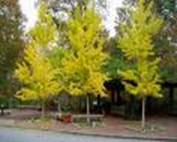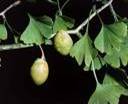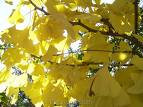| Kingdom | Plantae |
| Unranked | Angiosperms |
| Unranked | Eudicots |
| Order | Sapindales |
| Family | Burseraceae |
| Genus | Boswellia |
| Species | thurifera |
| Binomial name | Boswellia thurifera |
Other Common Names:
The other common names for Bai Guo, Ginkgo, Ginkgo Nut, Maidenhair Tree and Yin-hsing.
History
The ginkgo tree is one of the oldest types of trees in the world. Ginkgo seeds have been used in traditional Chinese medicine for thousands of years, and cooked seeds are occasionally eaten. Ginkgo is considered the oldest tree species to survive on earth, with a history dating back over 200 million years. Ginkgo species were once common in North America and Europe.

Description
This is a very hardy, dioecious tree with light green fan shaped leaves. It can reach heights up to 125 feet and is extremely hardy, as it is resistant to many insects, diseases and pollution. The bark of the tree is grayish brown with irregular ridges, eventually becoming deeply furrowed. The twig is light reddish brown, becoming grey with numerous and obvious spur shoots; buds are broadly conical to dome-shaped and reddish brown.


Range
Gingko is grown as a plantation crop in many parts of China, France and South Carolina. The gingko herb is native to China and perhaps also grows in the wild in the Japanese islands.
Habitat
Prefers moist, deep, sandy soils in full sun, but is very adaptable to stressful situations, including poor soils, compacted soils, various soil pHs, heat, drought, Winter salt spray, and air pollution and is therefore very urban tolerant.
Cultivation
Seed more fertilized Ginkgo seeds in covered container with wet sand in March. After 1 - 2 months take out germinating seeds and plant them in flower pot or in the garden. Young Ginkgo plant needs nearly full shade for first 2 - 3 years. Only if the young Ginkgo tree is high at least 30 cm, it can enjoy full sun. If small Ginkgo tree in free nature is planted, and then must be protected the south side with a broad board or with bush, several corn plants or with other biological material (see illustration - young Ginkgo tree with the sunlight's shaded from south side). Young Ginkgo tree prospers well in light soil or in the substrate, which consists of 1 part sand and 1 part humus.
Too much water could destroy also the young Ginkgo plant by dying the roots. Flower pot for Ginkgo must have therefore a hole. It is recommended to fertilize with the chicken muck and not with synthetic commercial fertilizer. To cultivate a Ginkgo in order to enjoy a harvest of the Ginkgo fruits in the garden or in the park, it is recommended to plant at least 3 - 4 trees at the same time on the same plot, whereby at least one plant must have female sex. In case of cultivation of the Ginkgo trees in free nature we should consider predominant wind direction in the area and facilitate thus the way of the pollen from the male Ginkgo tree to female Ginkgo tree. It is recommended to keep distance up to 100 m between female and male Ginkgo tree. We obtain best conditions for pollination however if we cultivate the Ginkgo trees both sexes pushed next to each other.
Flowering Season
It blooms from May to June, whereby male and female blooms grow on different trees - Ginkgos are dioeciously and they bloom from May to June. Small, yellow-green male blooms occur into compound, down-hanging blooms, which are similar to the male blooms of maple or birch. Yellow-green female blooms - ovules grow individually or in pair on short stalk as seed germ of the future fruits.
Pests and Diseases
The unusual shape of the crown, natural resistance to disease, and yellow leaf colour in fall makes this a favourite street and park tree. They rarely suffer disease problems, even in urban conditions, and are attacked by few insects.
Parts Used


The leaves and seeds are the most commonly used parts of the Ginkgo tree for its medicinal and commercial purposes.
Medicinal Applications


• The ginkgo sides work as herbal antioxidants throughout the body, and enhance the microcirculation of capillary beds throughout the body. This is why Ginkgo is beneficial to all organs that have rich blood supplies, including the heart,brain,liver, kidneys, lungs, and spleen, to mention only a few.
• Ginkgo has also been shown to be beneficial for headaches, vertigo, dizziness, hearing loss, allergies, and many more common ailments.
• Ginkgo Biloba may also slow the onset of Alzheimer's disease.
• It is considered to be an excellent herbal medicine for the treatment of problems such as arteriosclerosis, problems like high blood pressure, as well as angina and remedies based on gingko are often given to prevent the occurrence of strokes as well as heart attacks in susceptible people.
• Ginkgo Biloba lowers blood pressure, inhibits blood clotting, relieves muscle pain and has anti-aging properties.
• Ginkgo is also used for the following conditions mountain sickness, macular degeneration, asthma and hypoxia.
• Ginkgo leaves have been used for improving blood flow, memory loss due to certain brain problems like Alzheimer's disease, stroke as well as for relieving dizziness, and for ringing in the ears.
• Ginkgo extracts are used in skin products.
• It was traditionally used for the treatment of asthma and other respiratory ailments.
• The seed remedy is also used in the treatment of excessive urination and incontinence as well as a major herbal tonic for the treatment of the kidneys and the urinary bladder.
Commercial Applications


• The seed can be boiled and used in soups, porridges etc.
• The raw seed is said to have a fish-like flavour.
• It is a good source of starch and protein, but is low in fats.
• An edible oil is obtained from the seed.
• An oil from the seed is used as a fuel in lighting.
• A soap substitute is produced by mixing the pulp of the seed with oil or wine.
• The wood is light and soft and is used in furniture manufacture.
• It is also used as an insect repellent.

It is the symbol of the symbiosis, longevity and strong immunity.
Gingko is an aphrodisiacal herb, and a fertility herb. Gingko seeds are sometimes substituted for Lotus seeds at weddings and feasts. The wood can be carved into amulets and charms and carried as a healing herb. Gingko is very useful in ritual healing, and is considered by some to be the sacred Tree of Life. Due to the age of this species it is considered an elder among trees and having high spirit energy. The nuts, when dried, may be used to represent male fertility. Although they have been used as an aphrodisiac, they are useful in all creative work and may be included in a hand fasting feast.
A specimen Ginkgo tree in Lijiawan, Guizhou, China is 40 m tall with a dbh of 471 cm, and another at Dabao in Gansu is 60 m tall with a 286 cm dbh.One at Yongmun-san temple in South Korea is 36 m tall with a 457 cm dbh (Carder 1995). The largest in North America may be a tree planted in 1789 at Pierce Arboretum (now part of Longwood Gardens) in Kennett Square, PA. By 1968 that tree was 105 ft. tall and about 13 ft dbh.Seeds are sold in ethnic markets as silver almonds" or "white nuts," the gametophyte and embryo being edible.
Sometimes it is thus designated as the oldest tree at all and living fossil. It is the only living link between low and higher plants, between ferns and conifers. The oldest tree species in the world, dating from the time of the dinosaurs, Gingko biloba (bi-loba, two sided leaf) is the last remaining species of the Ginkoales order. Fossil records show the species was once widespread in Asia and North America, and it is speculated that it was saved from extinction by monks in the far east who cultivated it secretly as a sacred tree.The ginkgo is the official tree of the city of Kumamoto, and two leaves form the symbol of the University of Tokyo, the main campus of which is famous for its numerous ginkgos.